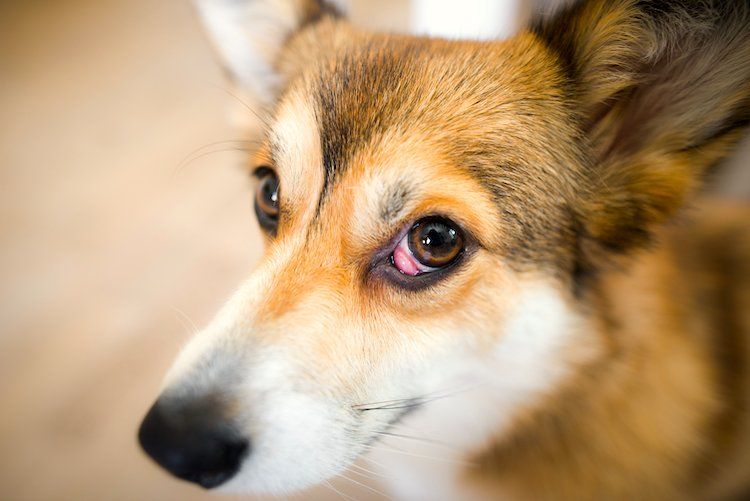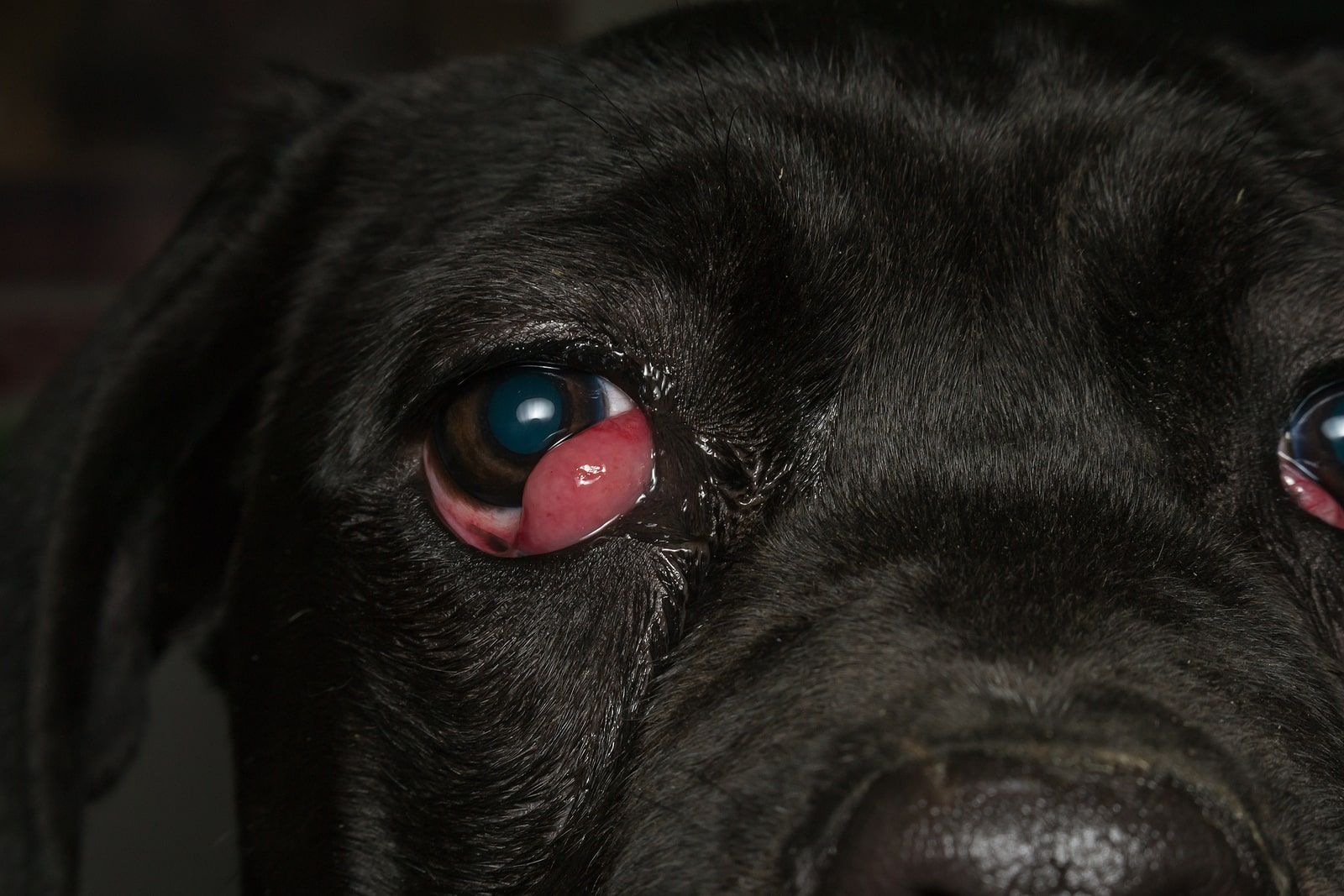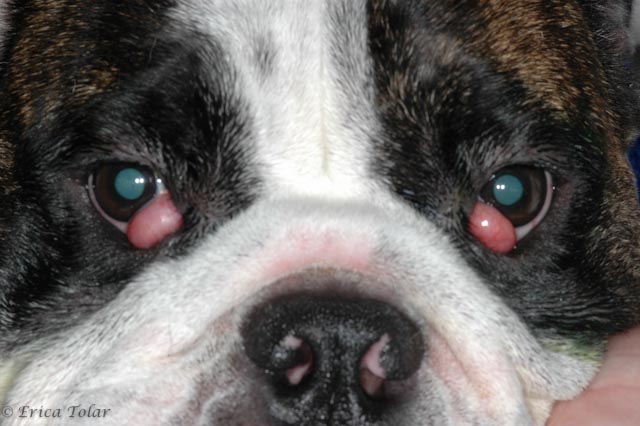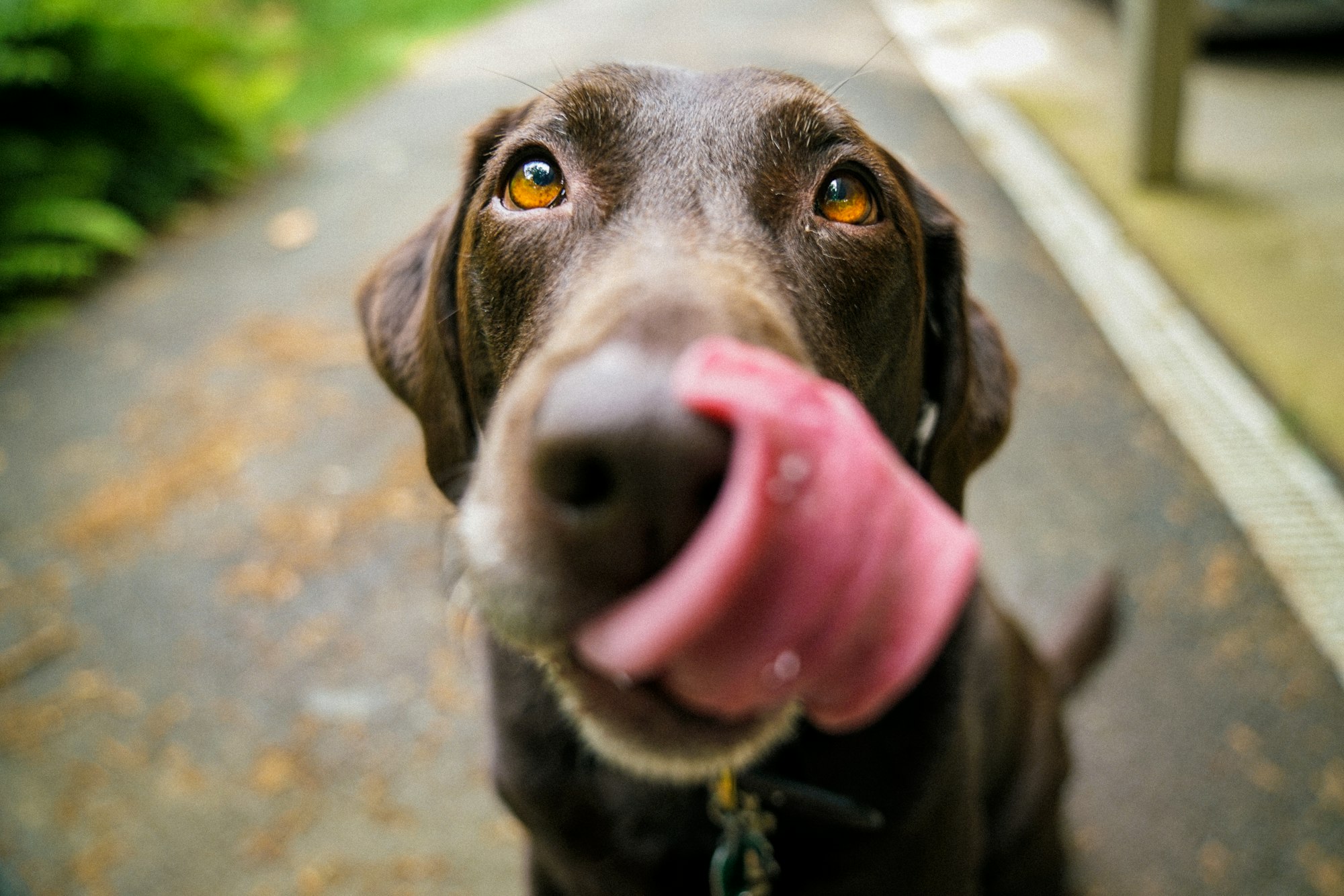Cherry eye is a relatively common eye condition that can affect dogs, particularly certain breeds. While it might sound harmless, it's important for dog owners to understand this condition, its causes, and how to best care for their furry friends if they develop cherry eye.
What is Cherry Eye?
Cherry eye, also known as nictitans gland prolapse or prolapsed third eyelid gland, is a condition where the gland located in the dog's third eyelid becomes swollen and protrudes from the corner of the eye. This condition is called "cherry eye" due to the red, round appearance of the gland, which resembles a cherry.

Symptoms of Cherry Eye
Cherry eye is a distinctive eye condition in dogs, and recognizing its symptoms is crucial for early detection and treatment. Common signs of cherry eye include:
1. Prolapsed Gland: The most apparent symptom is the prolapsed gland itself, which appears as a pink or red mass in the corner of your dog's eye, resembling a cherry.
2. Excessive Tearing: Dogs with cherry eyes often exhibit increased tearing or watery eyes. This is a response to the irritation caused by the prolapsed gland.
3. Squinting and Discomfort: Due to the discomfort caused by the condition, dogs may squint or keep the affected eye partially closed.
4. Pawing at the Eye: Some dogs may paw at their affected eye in an attempt to relieve the discomfort.
Causes of Cherry Eye
Understanding the causes of cherry eye is essential for both prevention and effective management. While the exact cause isn't fully clear, there are several contributing factors:
1. Genetic Predisposition
Certain dog breeds are genetically predisposed to cherry eye. Breeds like Bulldogs, Beagles, Cocker Spaniels, and Boston Terriers have a higher likelihood of developing this condition.
2. Weak Connective Tissues
Cherry eye can occur when the connective tissues supporting the gland in the third eyelid are weaker than usual. This weakness allows the gland to prolapse more easily.
3. Environmental Factors
External factors, such as eye injuries or infections, can sometimes trigger cherry eye or worsen an existing condition.
It's important to note that while these factors contribute to the development of cherry eye, not all dogs with these risk factors will develop the condition. Early veterinary intervention and proper care are key to managing cherry eye effectively.

Breeds Prone to Cherry Eye
Cherry eye, also known as nictitans gland prolapse or prolapse of the third eyelid gland, is a condition that can affect dogs, and some breeds are more prone to it than others. While cherry eye can occur in any dog, it is more commonly seen in the following breeds:
- Bulldog: English Bulldogs, French Bulldogs, and other bulldog breeds are known to have a higher predisposition to cherry eye.
- Cocker Spaniel: Cocker Spaniels are another breed that is frequently affected by cherry eye.
- Boston Terrier: Boston Terriers have a higher likelihood of developing cherry eye compared to some other breeds.
- Beagle: Beagles can also be prone to this condition.
- Lhasa Apso: Lhasa Apsos are a toy breed that can be susceptible to the cherry eye.
- Shih Tzu: Shih Tzu, known for their long, flowing coats, are another breed that can experience cherry eye.
It's important to note that while these breeds may be more predisposed to cherry eye, the condition can still occur in any dog. Cherry eye is characterized by the protrusion of the third eyelid's gland, causing a red, fleshy mass to appear in the corner of the eye. If you suspect your dog has a cherry eye, it's crucial to consult a veterinarian for proper diagnosis and treatment.
Diagnosis and Veterinary Examination:
When you notice symptoms of cherry eye in your dog, such as redness, swelling, or a fleshy mass in the corner of the eye, it's essential to seek prompt veterinary attention. A veterinarian will perform a thorough examination to diagnose cherry eye and determine the appropriate treatment. Here's what you can expect during the diagnosis and veterinary examination process:

- Physical Examination: The veterinarian will begin by conducting a physical examination of your dog, paying special attention to the affected eye. They will assess the extent of the prolapse and check for any signs of infection or other eye issues.
- Medical History: The vet will inquire about your dog's medical history, including any previous eye problems or chronic conditions that might contribute to the condition.
- Diagnostic Tests: In some cases, the vet may perform additional diagnostic tests, such as eye staining with fluorescein to rule out corneal ulcers or swabs to check for infection.
- Treatment Options: Once cherry eye is confirmed, the veterinarian will discuss treatment options with you. Treatment typically involves surgical correction to reposition the gland and prevent recurrence. The specific surgical technique used may vary depending on the vet's preferences and the severity of the condition.
Identifying the Condition
Veterinarians typically diagnose cherry eye through a physical examination and may recommend additional tests, such as tear production tests or eye swabs, to assess the overall eye health.
Treatment Options
When a dog is diagnosed with cherry eye, there are two primary treatment options to consider, each with its own set of advantages and considerations:
Surgical Intervention
Surgery is often the preferred method for treating cherry eye, especially in cases where the gland has fully prolapsed. Here's what you need to know about this treatment option:
- Procedure: During surgery, the veterinarian will reposition the prolapsed gland and secure it in place. This procedure aims to restore the gland to its normal position within the third eyelid.
- Advantages: Surgical intervention can be highly effective, providing a more permanent solution to the cherry eye. It reduces the risk of recurrence and discomfort for the dog.
- Post-Surgery Care: Following surgery, your veterinarian will provide specific instructions for post-operative care, which may include the use of antibiotics, pain medication, and protective measures to ensure a smooth recovery.
Medical Management
In some cases, especially when cherry eye is in its early stages or when surgery isn't immediately feasible, veterinarians may recommend medical management:
- Treatment: Medical management typically involves the use of prescribed eye drops or ointments. These medications aim to reduce inflammation and alleviate discomfort. However, it's important to note that this approach is often less effective in the long term compared to surgery.
- Advantages: Medical management can be a temporary solution to relieve discomfort and reduce inflammation. It may serve as a short-term measure while planning for surgery.
- Regular Monitoring: Dogs receiving medical management for cherry eye will require regular monitoring by a veterinarian to assess the effectiveness of the treatment and make necessary adjustments.
Post-Surgery Care
After surgical intervention for cherry eye, providing proper post-surgery care is essential to ensure a successful recovery and minimize complications:
- Medications: Your veterinarian will prescribe antibiotics and pain medication to prevent infection and manage discomfort. Administer these medications as directed.
- Protective Measures: Protect your dog's eye from potential irritants, such as dust and foreign objects, during the healing process. Your vet may recommend using an Elizabethan collar to prevent your dog from pawing at the operated eye.
- Follow-up Appointments: Attend all scheduled follow-up appointments with your veterinarian. They will monitor the healing process, check for any signs of infection or complications, and make necessary adjustments to the treatment plan.
- Avoid Stress and Physical Exertion: Limit your dog's physical activity during the initial recovery period. Avoid strenuous exercise and play that could strain the eye.
- Nutrition: Ensure your happy dog receives a balanced diet to support the healing process. Consult with your vet if dietary adjustments are necessary.
Preventing Cherry Eye
While it may not always be possible to prevent cherry eye, there are steps you can take to reduce the risk, especially in breeds prone to this condition:

Breeding Considerations
- Breeding Practices: If you're a breeder or considering breeding, be cautious when breeding dogs with a history of cherry eye. This condition can have a genetic component, so responsible breeding practices are crucial.
Environmental Factors
- Eye Protection: Protect your dog's eyes from potential injuries. Use goggles or protective eyewear in situations where there is a risk of eye trauma.
- Hygiene: Maintain good eye hygiene by regularly cleaning your dog's eyes with a veterinarian-recommended eye wash solution. This can help prevent eye infections that may exacerbate cherry eye.
Complications and Risks
It's important to be aware of potential complications and risks associated with cherry eye, including the possibility of recurrence or the development of other eye conditions.
Potential Issues
Dogs with cherry eye may be at risk of chronic dry eye (keratoconjunctivitis sicca) or conjunctivitis if not treated promptly and effectively.
Cherry Eye vs. Other Eye Conditions
Distinguishing cherry eye from other eye conditions is crucial for proper diagnosis and treatment. Conditions like conjunctivitis or corneal ulcers can present similar symptoms but require different approaches.
Living with a Dog with Cherry Eye
Living with a dog affected by the cherry eye requires attention, care, and understanding. While this condition can be concerning, it's entirely manageable, and many dogs with cherry eyes lead happy, healthy lives. Here's what you should know about living with a dog with cherry eye:
- Regular Monitoring: Keep a close eye on your dog's eyes and the affected eye in particular. Monitor for any changes, such as swelling, redness, or signs of discomfort.
- Follow Veterinary Recommendations: Adhere to your veterinarian's recommendations for treatment and post-surgery care diligently. This includes administering prescribed medications and attending follow-up appointments.
- Prevent Irritation: Prevent your dog from pawing at the affected eye. An Elizabethan collar or gentle discouragement can help reduce irritation and the risk of further complications.
- Eye Protection: In dusty or windy environments, consider protective eyewear for your dog to shield the eyes from potential irritants.
- Balanced Diet: Ensure your dog receives a balanced diet to support overall health, including eye health. Consult with your veterinarian for dietary recommendations if needed.
- Quality of Life: Most dogs adapt well to living with the cherry eye, especially after surgery. Provide a comfortable and loving environment to maintain their quality of life.
- Routine Veterinary Visits: Continue with routine veterinary check-ups to monitor your dog's overall health and address any emerging issues promptly.
When to Consult a Veterinarian
Timely veterinary intervention is crucial when it comes to cherry eye. If you notice any of the following signs or have concerns about your dog's eye health, consult a veterinarian promptly:

- Appearance of a Red or Pink Mass: If you see a red or pink mass in the corner of your dog's eye, it's a clear indication of cherry eye and should be examined by a vet.
- Excessive Tearing: Persistent tearing or watery eyes, especially when accompanied by squinting or discomfort, may be a sign of cherry eye.
- Change in Eye Behavior: If you observe your dog rubbing or pawing at their eye, blinking excessively, or keeping the eye partially closed, it's an indication of eye discomfort and should be evaluated.
- Swelling or Inflammation: Any noticeable swelling, redness, or inflammation around the eye area should not be ignored.
- Change in Eye Color or Clarity: If you notice a change in the clarity or color of your dog's eye, such as cloudiness or a change in pupil size, consult a veterinarian.
- Behavioral Changes: Sudden changes in your dog's behavior, such as increased agitation or restlessness, may also be related to eye discomfort.
Remember that prompt treatment is essential to prevent complications and discomfort for your dog. If you suspect your dog has a cherry eye or notice any concerning symptoms, don't hesitate to reach out to a veterinarian for a proper diagnosis and treatment plan.
Caring for a Dog with One or Both Eyes Affected
If your dog has cherry eye in one or both eyes, providing proper care and following your veterinarian's guidance is crucial for their long-term eye health. Here are some important considerations:
- Medication Adherence: If your dog is prescribed medication, administer it as directed by your veterinarian. Be consistent to ensure the effectiveness of the treatment.
- Eye Protection: If your dog has cherry eye in one eye, take extra precautions to protect the unaffected eye from potential irritants or injury.
- Regular Veterinary Check-ups: Continue with regular veterinary visits to monitor the affected eye's progress and address any concerns promptly.
- Maintain a Calm Environment: Minimize stressful situations and activities that could potentially worsen eye discomfort.
- Balanced Nutrition: Ensure your dog receives a balanced diet to support overall health, including eye health.
- Consultation for Surgery: If both eyes are affected or the condition is severe, discuss the possibility of surgical intervention with your veterinarian.
Conclusion
Cherry eye in dogs is a condition that requires attention and care. Understanding its causes, symptoms, and treatment options can help you provide the best possible care for your furry friend. If you suspect your dog has a cherry eye or notice any concerning symptoms, consult your veterinarian promptly for a proper diagnosis and treatment plan.
Frequently Asked Questions (FAQs)
- Q1: Can cherry eye go away on its own without treatment?
- In most cases, cherry eye does not resolve on its own and requires treatment.
- Q2: Is cherry eye painful for dogs?
- Cherry eye can be uncomfortable and may cause irritation and discomfort for dogs.
- Q3: Are all dog breeds equally prone to cherry eye?
- No, certain breeds are more genetically predisposed to cherry eye than others.
- Q4: Can cherry eye recur after surgery?
- While surgery can effectively treat cherry eye, there is a slight risk of recurrence.
- Q5: What should I do if my dog has cherry eye symptoms?
- If you suspect your dog has cherry eye, consult a veterinarian for a proper diagnosis and treatment plan.






